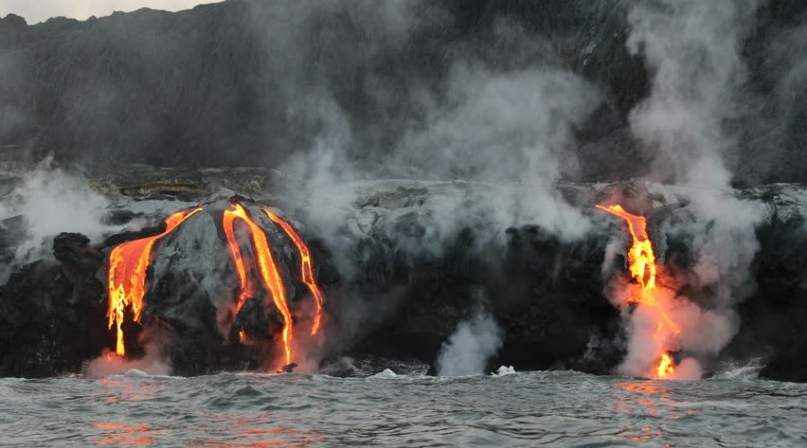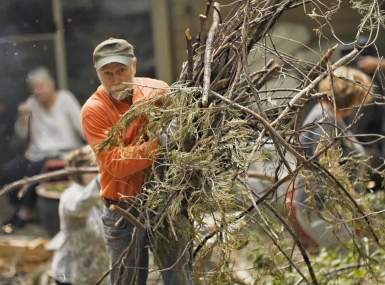Oozing lava, noxious gases, Pele mark volcano’s eruption in Hawaii

Hawaii County projects a $3 million property tax loss and a $6 million budget shortfall thanks to expenses from the Mt. Kilauea eruption
Nineteen days after Mt. Kilauea erupted sending lava oozing into the streets of her district, Hawaii County Councilmember Eileen O’Hara is recounting her biggest concern for the day — lava closing in on a nearby geothermal power plant.
Learn More
“The lava is now within a football field of it,” she said. “If it blows, I told my staff to get out of town. My office is five or six miles away as the bird flies but there’s no wind today, and it’ll settle like a pancake on the environment for miles around.” Fumes could sicken people and damage crops, she noted.
“That’s the concern for today but every day there’s a new concern,” she said.
An ongoing problem, she said, is residents who have lost their homes and farmers whose livelihoods have been put on hold. Beekeepers, ranchers and papaya growers haven’t been able to access their fields, she said. “They can’t get in and harvest and their crops are at harvest stage.”
In addition to the problems of the residents and farmers is the impact on the county budget. The volcano eruption was discussed May 22 at the council’s budget meeting including how it might impact property taxes as well as the county’s bond rating.
Looking at the affected area, the county will likely see a projected loss of $3 million in property taxes in 2018 and is expecting to see a total budget shortfall of up to $6 million due to expenditures related to the eruption, the county finance director said.
The financial impact to the county so far has been about $1.4 million including $745,000 in overtime pay (to May 15), $560,500 in road repairs, $65,000 in security and meals and $9,900 in other services.
The county expects to recover some of its costs from FEMA and is looking at perhaps cutting the tourism and business development budgets or raising property taxes.
The land hit by the fiery lava from the erupting volcano, where dozens of homes have been destroyed, features farms and neighborhoods and has an interesting history in the region.
“It was a land speculation scam,” O’Hara said, referring to the 1958 deal chronicled in Land and Power in Hawaii, which describes how two Colorado businessmen bought 12,000 acres of land on the world’s most active volcano and sold it in thousands of lots.
Two years later, 11 subdivisions were underway, including Leilani Estates, sited directly on top of Kilauea Volcano’s East Rift Zone. “They came here to the lava fields of Puna,” O’Hara said. “No roads, no water, nothing. They sold lots.”
“We are now paying for it in many ways because the lack of connectivity between these subdivisions…is compounding the problems we’re having now in terms of circulating people out of harm’s way,” O’Hara said, referring to the Kilauea volcano eruption that started May 3, engulfing 26 homes in Leilani Estates. At last count, 40 homes were destroyed in the area.
“We had a flurry of earthquakes and the USGS had put us on alert that we could see an eruption,” she said. “But we live on the flank of the most active volcano in the world, which has erupted many, many times and people kind of shrug it off.”
Residents were returning home from work May 3 to find out that the volcano was indeed erupting. “Most people had an hour or two to get out, and then they were prevented from going back,” O’Hara said. They weren’t allowed to return during daylight hours “until we had some sort of supervised entry, which was chaotic as all get out.”
Once the volcano erupted, the fume levels from hydrogen sulfide and sulfur dioxide got dangerously high. “It’ll kill ’ya,” O’Hara said. “Especially if there’s moisture in the air.”
A second eruption, May 17, sent ash 30,000 feet into the air, according to the U.S. Geological Survey.
On May 19, the lava reached the ocean, creating a lava and haze mix or “laze.” It sends volcanic gas and hydrochloric acid into the air; the fumes can cause lung, eye and skin irritation. Officials have warned residents to stay indoors. The USGS is also warning people about ballistic projectiles shooting from the volcano. The USGS Hawaiian Volcano Observatory said the last time the lava met the ocean was in August 2013.
In addition to fumes from the volcano, residents were also concerned about the nearby geothermal plant, which was shut down, O’Hara said. Many of the homes are within a mile of the plant, which is home to thousands of gallons of flammable chemicals including pentane. “They always have 50,000 to 60,000 gallons of pentane on hand,” she said. “And knowing that, the community was very concerned when this all started.”
The pentane was eventually stored offsite. The plant worked to “quench” the wells — filling them with water (one with mud) and sealing them, she said.
Meanwhile the county was stepping up to the plate itself opening two shelters with help from the American Red Cross and the Salvation Army, using a community center where cots were set up and a newly built sports park with a large gym. A lot of people are “staying in the parking lot in their trucks,” where they are hanging out with their pets, she said. Both shelters are pet friendly. During one of O’Hara’s visits, about 500 people were at one of the shelters; at least 2,000 were evacuated. The National Guard is activated and is going door to door in evacuated areas, she said. “Everybody’s taking in people,” she said. A water delivery truck driver took in 12 senior citizens who are her customers.
Another concern is whether those with insured homes will be covered or not. O’Hara said she is trying to work with the insurance commissioner to find out if residents’ insurance policies might cover damages caused by fire, which takes place before a house is engulfed by lava, she said.
She has also met with residents at Civil Defense meetings at the high school cafeteria. The first meeting, held the Friday night after the Thursday eruption, was standing room only.
Speaking with a resident whose family goes back generations in the area, O’Hara was given a very unscientific explanation for the volcanic activity — it’s actually a myth being played out between the volcano goddess Madame Pele and the volcano god she replaced years ago.
O’Hara is also keeping in touch with constituents on social media, mainly through her Facebook page, and is fielding phone calls, emails and texts each day from concerned residents.
The biggest worry: “When can we go home?” O’Hara said. Civil Defense, based on reports from USGS and other scientists, would make the call when residents can return. “We’re not out of the woods yet.”
About Volcanoes
How many active volcanoes are there in Hawaii? | There are three active volcanoes in Hawaii; Mauna Loa and Kilauea on Hawaii Island at Volcanoes National Park. A third, Loihi, is located underwater off the southern coast of Hawaii Island. Kilauea, which has been continuously erupting since 1983, is responsible for the current volcanic activity on the Big Island. |
What is the world’s largest volcano? | If you’re talking about visible on land, and still active, you’re talking Mauna Loa, again. The volcano is 75 miles long; 30 miles wide; and 13,680 feet (2.6 miles) above sea level. By way of contrast, its sister volcano, Kilauea, is 4,091 feet high. |
What is a volcano? | A volcano is an opening on the surface of a planet that allows material warmer than its surroundings to escape from its interior. When this material escapes, it causes an eruption. An eruption can be explosive, sending material high into the sky. Or it can be calmer with only lava flows. |
What is a volcanic fissure? | A volcanic fissure is a linear volcanic vent through which lava erupts, usually without any explosive activity. |
How many active volcanoes are there in the world? | There are about 1,500 potentially active volcanoes worldwide. |
Attachments
Related News

White House launches federal flood standard support website and tool
On April 11, the White House launched a new website and mapping tool to help users with the ongoing implementation of the Federal Flood Risk Management Standard (FFRMS).

As disasters increase, counties must invest in mitigation
Disasters are becoming more frequent, more severe and more costly, and counties, parishes and boroughs are on the front lines — where the immediate response is handled and where the personal impact is felt.

Micro-grants help fireproof a neighborhood by reducing fuel
Nevada County, Calif. helped communities reduce the vegetation that could easily spread fire in neighborhoods.
